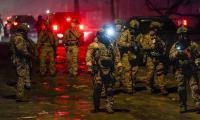The meaning of Allama Khadim Rizvi
Did Jinnah ever say that Pakistan would be a laboratory of Islam? If he did not, why is it one of his most quoted quotes and why has found its way into our textbooks? Is it because our rulers have spent a good part of their energies turning Pakistan in to a Frankenstein’s workshop, and wanted on their achievements the seal of approval of the founder of the nation posthumously?
During the last four decades, we have produced all kinds of sipahs and lashkars but one thing, one important thing, was missing and now we have it in the form of the Tehreek-e-Labaik Ya Rasul Allah (TLYR), carrying the flag of violent, assertive Barelvism. (We did have the Karachi-based Sunni Tehreek but Karachi is so far from Islamabad). This new beauty born on the confluence of Rawalpindi and Islamabad may prove a bigger challenge to Pakistani society than any other religious outfit because of its social rootedness.
During the last few decades, Pakistan’s educated middle class created a naïve narrative based on a binary between the violent Saudi influenced Wahabi/Deobandi Islam and the peaceful indigenous Sufi/Barelvi Islam. Such a distinction, though not completely devoid of substance, is deeply problematic. Deobandi Islam is hugely influenced by Sufi tradition and Barelvi denomination cannot be equated with Sufi Islam. Wahabi Islam had existed in Saudi Arabia since the middle of the eighteenth century without creating any militant threat to society.
Those who try to find sources of violence in ideology are often barking up the wrong tree. Any ideology, religious or secular, can be distorted to create havoc in a society. What can be more peaceful than linking man with the Divine? All religions and all Muslim denominations are inherently peacefully. However, there is hardly any large religion that has not been used by men to inflict wounds upon others and upon themselves.
The Sajjada Nasheens (custodians of shrines), whom we associate with the Barelvi sect today have been politically active for centuries, building alliances with rulers and, at times, resisting them. Many of them also played a crucial part in the Pakistan movement. However, as an important segment of the traditional elite, they did not associate themselves with any single political party. With the changing political winds, they have changed their individual political alliances.
The power of Sajjada Nasheens makes Barelvi politics unstable vis-à-vis Deobandi religious politics. The Deobandi religious leadership is in the hands of middle-class religious scholars who are often managers-cum-owners of large madressahs. Their power lies in their madressahs. Therefore, they are always in search of enlarging and extending the network of their seminaries and students.
The TLYR can be seen as a movement that is rooted in Barelvi madressahs and lays a direct challenge to the power of Sajjada Nasheens. Khadim Hussai Rizvi grew up at different madressahs and still draws a salary of Rs15000 from a mosque where he works as a khateeb (imam for the Friday prayers). The party took birth as a madressah in Lahore as a movement working for the release of Mumtaz Qadri. Allama Rizvi openly expresses his hatred for rich Sajjada Nasheens and their spoilt children. No wonder, all the efforts of the government to influence him through powerful Sajjada Nasheens failed during the recent dharna.
Khadim Hussain Rizvi and his party has found resonance with a section of Pakistani society that had been left untouched by the political activism of the PTI and were discontent with the patronage politics of other parties. In many ways, Allama Khadim Hussain Rizvi can be equated with Imran Khan. While Imran Khan has mobilised the educated middle class by articulating their frustration, Maulana Rizvi has mobilised the religiously inclined lower, middle and working class. In other words, he has mobilised a section of what Guy Standing, a SOAS professor, has termed as precariat. According to him: “In sum, the precariat lives in economic uncertainty, usually in chronic unsustainable debt, in which one shock, mistaken decision or illness could tip them over the edge into the under-class, cut adrift from society and probably condemned to social illness or an early death.”
Both political parties have emerged out of the rapid social change in Pakistani society and deeply ingrained psychological and economic fears rooted in globalisation. Both parties have mobilised their followers on their programme, defying politics of patronage and clientalism, though the PTI had to fall back upon politics of patronage in Khyber Pakhtunkhwa. Both are 3G parties as they have relied heavily on social media to convey their simplistic but extremely powerful narratives. Perhaps Allama Rizvi relies more on social media than Imran Khan, as the mainstream media is often reluctant to air his speeches for linguistic reasons.
Rizvi’s social agenda is not upfront, but he does emphasise the message of social equality and the responsibility of the state to fulfil the needs of the poor. He finds all solution to all problems in power (use of force). In his words, all ills can be solved by putting religion in power – that is, giving power to ulema. In this he resembles Islamists like the Jamaat-e-Islami and jihadi leaders like Hafiz Saeed of the Lashkar-e-Taiba.
Imran Khan targets a small unidentified ruling corrupt elite. He defines this elite as a few hundred politicians. For Rizvi, all politicians and the whole of the upper class is suspect in religious terms including the “son-in-law of Jews”, Imran Khan.
Allama Rizvi has shaken the pillars of a state always in awe of anyone supporting a beard and turban. What is even worse, some sections of Pakistan’s ruling elite may still be making instrumental use of religion in their internal power struggles. With a vulnerable and besieged government at the helm, the executive authority of the state lays in tatters. The executive arm of the state was already on the brink due to the extreme demands put on it due to terrorism, crime and political protests. Excessive judicial accountability and humiliation by protesters and courts have bankrupted it altogether.
An equally grim challenge comes from the loss of the legitimacy of the political class to rule the country. As a result of Imran Khan’s unrelenting mud-slinging, political leaders, including Imran Khan himself, stand tarnished. According to a survey conducted by Gallup Pakistan, while 65 percent Pakistanis consider the PML-N corrupt, no less than 55 percent think that the PTI is corrupt as well. This creates a huge scope for new challengers and religious groups.
There can be at least half a dozen scenarios to predict the future of the TLYR and its influence on Pakistan’s politics. In the short run, it can prove to be a huge headache for the established political parties, established political classes and the authority of the state. There are many books written to help people suffering from suicidal ideation ie suicidal thoughts. I do not know of any book written to help a state bent on self-harm.
The writer is an anthropologist and development professional.
Email: zaighamkhan@yahoo.com
Twitter: @zaighamkhan
-
 Philippines Blocks Elon Musk’s Grok AI
Philippines Blocks Elon Musk’s Grok AI -
 Jennifer Lawrence Blames Internet For Losing Sharon Tate Role
Jennifer Lawrence Blames Internet For Losing Sharon Tate Role -
 DeepMind, Google CEOs Sync Daily To Accelerate AI Race Against OpenAI
DeepMind, Google CEOs Sync Daily To Accelerate AI Race Against OpenAI -
 Japan Launches Probe Into 'Grok AI' Following Global Scrutiny Over 'inappropriate' Content
Japan Launches Probe Into 'Grok AI' Following Global Scrutiny Over 'inappropriate' Content -
 Prince Harry All Set To Return To Britain Next Week?
Prince Harry All Set To Return To Britain Next Week? -
 Is Princess Charlotte Becoming Most Confident Young Royal?
Is Princess Charlotte Becoming Most Confident Young Royal? -
 ‘Stranger Things’ Star David Harbour Speaks Up About ‘psychotherapy’
‘Stranger Things’ Star David Harbour Speaks Up About ‘psychotherapy’ -
 Jennifer Love Hewitt Talks About Scary 9-1-1 Episode
Jennifer Love Hewitt Talks About Scary 9-1-1 Episode -
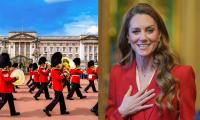 Kate Middleton Ditches Palace Life For Where She 'truly Relaxes'
Kate Middleton Ditches Palace Life For Where She 'truly Relaxes' -
 Pixel Watch May Soon Warn You If You Leave It Behind
Pixel Watch May Soon Warn You If You Leave It Behind -
 Serious Liver Scarring Shows Potential To Be Reversed With Latest Drug
Serious Liver Scarring Shows Potential To Be Reversed With Latest Drug -
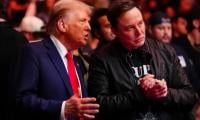 Elon Musk Backs Donald Trump To Invoke Insurrection Act Amid Minnesota Protests
Elon Musk Backs Donald Trump To Invoke Insurrection Act Amid Minnesota Protests -
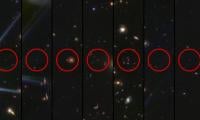 Scientists Unravel Mystery Of James Webb’s ‘little Red Dots’ In Deep Space
Scientists Unravel Mystery Of James Webb’s ‘little Red Dots’ In Deep Space -
 Nano Banana Explained: How Google’s AI Got Its Name
Nano Banana Explained: How Google’s AI Got Its Name -
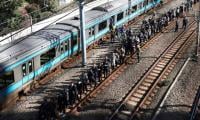 Fire Causes Power Outage On Tokyo Train Lines, Thousands Stranded As ‘operations Halted’
Fire Causes Power Outage On Tokyo Train Lines, Thousands Stranded As ‘operations Halted’ -
 YouTube, BBC To Ink Landmark Deal To Launch Exclusive Bespoke Shows
YouTube, BBC To Ink Landmark Deal To Launch Exclusive Bespoke Shows



